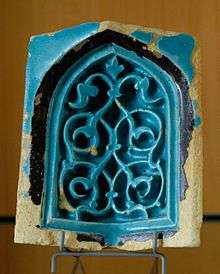Muqarnas

Muqarnas (Arabic: مقرنص; Persian: مقرنس) is a form of architectural ornamented vaulting, the "geometric subdivision of a squinch, or cupola, or corbel, into a large number of miniature squinches, producing a sort of cellular structure", sometimes also called a "honeycomb" vault.[1] It is used for domes, and especially half-domes in entrances, iwans and apses, mostly in traditional Islamic and Persian architecture. Where some elements project downwards, the style may be called mocárabe;[1][2] these are reminiscent of stalactites, and are sometimes called "stalactite vaults".
Muqarnas developed around the middle of the 10th century in northeastern Iran and almost simultaneously — but apparently independently — in central North Africa. Examples can be found in the Alhambra in Granada, Spain, the Abbasid Palace in Baghdad, Iraq, and the mausoleum of Sultan Qaitbay, Cairo, Egypt.[2] Large rectangular roofs in wood with muqarnas-style decoration adorn the 12th century Cappella Palatina in Palermo, Sicily, and other important buildings in Norman Sicily. Muqarnas is also found in Armenian architecture.
Structure

Muqarnas is typically applied to the undersides of domes, pendentives, cornices, squinches, arches and vaults.[2] Muqarnas is a downward-facing shape; that is, a vertical line can be traced from the floor to any point on a muqarnas surface. It is also arranged in horizontal courses, as in a corbelled vault, with the horizontal joint surface having a different shape at each level.[3][4] The edges of these surfaces can all be traced on a single plan view; architects can thus plan out muqarnas geometrically, as the image illustrates.[5][6] See these diagrams for clarity.


Muqarnas does not have a significant structural role. Muqarnas need not be carved into the structural blocks of a corbelled vault; it can be hung from a structural roof as a purely decorative surface.[7][8] Muqarnas may be made of brick, stone, stucco, or wood, and clad with tiles or plaster.[2] The individual cells may be called alveoles.[1]
Some modern muqarnas elements have been designed, if not built, with upwards-facing cells;[8] see also the Indian capitals above.
 Amber Fort, near Jaipur. The marble palace Jai Mandir. Sheesh Mahal (the Hall of Mirrors): note mirrors set in the ceiling.
Amber Fort, near Jaipur. The marble palace Jai Mandir. Sheesh Mahal (the Hall of Mirrors): note mirrors set in the ceiling. Muqarnas corbel, Qutb Minar, India
Muqarnas corbel, Qutb Minar, India Muquarnas, single. Earthenware with moulded decoration under opaque turquoise glaze, Timurid art, 1st half of the 15th century. From the Shah-i-Zinda in Samarkand.
Muquarnas, single. Earthenware with moulded decoration under opaque turquoise glaze, Timurid art, 1st half of the 15th century. From the Shah-i-Zinda in Samarkand.- Muqarnas on the underside of an arch, Alhambra Palace, Granada, Spain, likely in carved plaster. Note down-ward-projecting "stalactites".
- Painted muqarnas, Palatine Chapel, Palermo, commissioned by Roger II of Sicily in 1132

See also
- Architecture of Iran
- Islamic architecture
- Islamic geometric patterns
- Mathematics and art
- Ottoman architecture
References
- 1 2 3 VirtualAni website. "Armenian architecture glossary". Retrieved 2009-07-17.
- 1 2 3 4 Curl, James Stevens (2006). A Dictionary of Architecture and Landscape Architecture (Paperback) (2nd ed.). Oxford University Press. ISBN 0-19-860678-8.
- ↑ http://muqarnas.muqarnas.org/muq-course/index.html
- ↑ http://www.broug.com/learn_muqarnas.htm
- ↑ http://www.tamabi.ac.jp/idd/shiro/muqarnas/default.htm
- ↑ http://www.metta-physics.com/2011/05/islamic-art-geometry/
- ↑ http://www.slideshare.net/sharmiarchitect/muqarnas-mathematics-in-islamic
- 1 2 http://www.slideshare.net/danowen777/muqarnas-reconceived-a-brief-survey#
External links
- Muqarnas : A Three-dimensional Decoration of Islam Architecture. Contains a database of over a thousand plans of extant muqarnas, indexed by location and geometry.
- Abstract, Nexus 2004, Muqarnas, Construction and Reconstruction
- Modern muqarnas forms, Animated GIF version
- Informative page about muqarnas from the School of Islamic Geometric Design
- polygonal computer models
- Page with VRML interactive 3D models
- Slideshow on muqarnas geometry, with traditional and computer-assisted new designs.
| Wikimedia Commons has media related to Muqarnas. |

